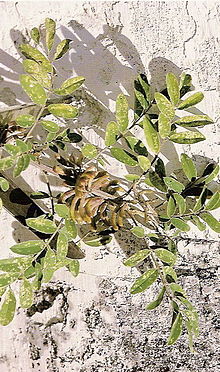Indigofera suffruticosa
| Anil | |
|---|---|

| |
| Scientific classification | |
| Kingdom: | Plantae |
| Clade: | Tracheophytes |
| Clade: | Angiosperms |
| Clade: | Eudicots |
| Clade: | Rosids |
| Order: | Fabales |
| Family: | Fabaceae |
| Subfamily: | Faboideae |
| Genus: | Indigofera |
| Species: | I. suffruticosa
|
| Binomial name | |
| Indigofera suffruticosa Mill., 1768
| |
| Synonyms | |
Indigofera suffruticosa, commonly known as Guatemalan indigo, small-leaved indigo (Sierra Leone), West Indian indigo, wild indigo, and anil,[2] is a flowering plant in the pea family, Fabaceae.
Anil is native to the subtropical and tropical Americas, including the Southern United States, the Caribbean, Mexico, Central America, and South America as far south as northern Argentina. This species has been widely introduced to other parts of the world and today has a pantropical distribution.[1] It is an erect branching shrub growing to 1 m (3.3 ft) tall with pinnate leaves, and is commonly found growing in dry, highly disturbed areas such as roadsides and fallow fields.


Anil is commonly used as a source for indigo dye, and if mixed with Palygorskite clays, can produce Maya blue, a pigment used by the Mesoamerican civilizations.
